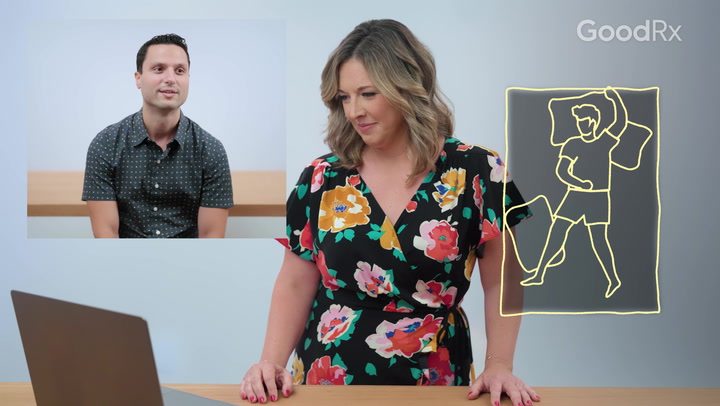
How to Sleep With Lower Back Pain: 4 Sleeping Positions to Make It More Comfortable
Key takeaways:
If you have back pain, the right sleeping positions can reduce the strain on your back and promote restful sleep.
Research suggests that sleeping on your side with a pillow between your knees may ease lower back pain.
Pillows and a supportive mattress can align your spine and support your back.
Table of contents
Lower back pain can make it difficult to fall or stay asleep. And if you wake up feeling stiffer or have more pain, your sleep position could be to blame. Certain postures — such as sleeping on your stomach — may increase the load on your spine. That can worsen lower back aches and pains and make it hard to catch some Zs.
Fortunately, making some simple changes — like switching positions — can help take the stress off your back. That way, you can get the rest you need. In one small study, older adults learned about the best sleeping postures. After 4 weeks, 90% had significantly less back pain.
Here's what you need to know about how to get better sleep with lower back pain.
Search and compare options
What are the best sleeping positions for lower back pain?
Are you a side or back sleeper? Or do you prefer sleeping on your stomach? In a review, researchers looked at all three of these common sleep positions. They found that two sleeping postures may help prevent or reduce low back pain: sleeping on your side with pillows or alternating between supported side-lying and supine (on your back) postures.
Sleeping on your stomach may increase your risk of back pain. That doesn't mean stomach sleeping is entirely off-limits, but you may need to make some modifications. The same review also found that sleeping on your side without a pillow between your legs increases back pain because it twists your torso.
If you have lower back pain, try these research-backed sleeping positions.
1. Sleep on your side with a pillow between slightly bent knees
Experts often advise sleeping on your side with a pillow between slightly bent knees if you have lower back pain. This position keeps the natural curves of your spine intact and supported. Experts also recommend this sleep posture to prevent and relieve back pain during pregnancy.
It is important to note that this position must be done with a pillow between your legs. Here’s what to do:
Lie on your side with your knees slightly bent.
Put a pillow under your head to keep your neck in a neutral position.
Place a pillow between your knees. This should stop your knees from shifting forward.
Use a small pillow under your midsection if there is a gap between your waist and the mattress. Doing this will help keep your spine straight.
Read more like this
Explore these related articles, suggested for readers like you.
Placing a pillow between your knees is essential for this position because it reduces pressure on your cervical spine. And try not to sleep on the same side every night. Switching sides can help you avoid pain or muscle imbalances.
2. Sleep on your side in the fetal position
The fetal sleeping posture might be helpful for people with osteoarthritis, spinal stenosis, or a lateral herniated disc. It's similar to the first position, but you flex your trunk and bend your knees farther. These changes can open the spaces between your vertebrae (back bones) to help relieve nerve pressure.
Here’s how to get into this position:
Lie on your side with a pillow under your head to keep your neck in a neutral position.
Round your trunk, and tuck your knees up toward your chest. This should help you move into a fetal position.
Use pillows as props for support and comfort. You can put pillows between your legs, under your legs to keep them bent, or behind your trunk to stop you from rolling back. You can also hold a body pillow in front for support.
3. Sleep on your back with a pillow under your knees
Sleeping supine or face-up on your back might help you avoid back pain. In this position, your weight is evenly distributed, which helps keep your spine neutral. But research on whether this position reduces lower back pain is mixed. Some studies say it does not, while others suggest it does, especially when combined with a supported side-lying posture.
To get into this position:
Lie on your back with a pillow under your head to support your neck.
Place a pillow or rolled-up towel under your knees to keep them slightly bent. This helps maintain the natural curve in your back.
Use a small pillow or rolled-up towel under the arch in your lower back for extra support and comfort.
4. Sleep on your stomach with a pillow under your pelvis
Sleeping prone or facedown on your stomach has been linked to back, neck, and shoulder pain. When you sleep on your stomach, your midsection may sink into the mattress, which arches your spine. You also have to turn your head in this position, which twists your neck.
However, you may find that stomach sleeping eases pain if you have degenerative disc disease or a herniated disc. People with these conditions often have pain with sitting (flexion) and relief with standing (extension). Sleeping on your stomach mimics a standing position.
If you prefer sleeping on your stomach, follow these tips:
Lie on your stomach, and turn your head to the left or right. You can use a thin pillow to support your head and neck.
Place a thin pillow under your pelvis to reduce pressure on your back and keep your spine aligned.
A firmer mattress is a good choice for stomach sleepers. It can add support and reduce pressure on your spine.
Choosing the right pillows and mattress for lower back pain
A supportive mattress and pillow can go a long way toward helping you get a restful night's sleep with lower back pain. There isn't one "best" mattress or pillow for people with lower back pain. Plus, there are so many options. And what works for some may not work for others.
However, there are qualities you can look for when shopping for a mattress or pillows. If your mattress is too soft, it will not support your spine and can cause back pain. If your mattress is too hard, it might be uncomfortable. Research suggests that medium-firm mattresses may improve sleep quality and decrease back pain. So that's a good place to start.
Your pillow should help support the natural curve of your neck. A memory foam pillow is one good option, as it molds and conforms to your neck.
Keep the following tips in mind to help you choose pillows and a mattress that works for you:
If you're a side sleeper, consider a medium-soft to medium-firm mattress with a firm, thick pillow. The mattress can provide enough support to keep your hips and shoulders aligned. The pillow will help keep your neck in line with your spine.
If you're a back sleeper, consider a medium-firm to firm mattress with a thin pillow. A firm mattress helps evenly distribute your weight to reduce pressure on your lower back. A thin pillow can reduce pressure on your neck.
If you're a stomach sleeper, consider a medium-firm to firm mattress with the thinnest pillow you can find. A firm mattress can help prevent your back from arching while you sleep on your stomach. And a really thin pillow — or no pillow — can prevent your neck from moving out of alignment with your spine.
Tips for how to sleep with lower back pain
One of the many benefits of sleep is that it can help your body recover, so you have less pain and better physical function. In addition to choosing a supportive sleep position, the following tips can help you sleep with back pain:
Try gentle stretches. A gentle stretching routine before bed can help improve blood flow to your muscles and relieve tension to promote better sleep.
Avoid caffeine. Try to stay away from caffeine later in the day. That includes sneaky sources of caffeine, such as chocolate or sodas.
Avoid alcohol. Some people notice that alcohol helps them fall asleep faster. But it can also make it harder for you to stay asleep. So it's best to avoid winding down with a glass of wine or other alcohol.
Minimize electronics. The light from your cell phone, computer, and television can make it difficult to fall asleep. Ditch your electronic devices at least 1 hour before bed. Try reading or meditating to help you relax before bed.
Take a warm bath. Soaking in a warm bath or taking a warm shower before bed may promote better sleep.
Keep your bedroom cool. Experts say the ideal temperature for sleeping is 65°F. You can also use a fan to help you stay cool at night.
When should you see a doctor for lower back pain?
Common causes of lower back pain include muscle strains, sprains, and spasms. Most cases will resolve in a few weeks with at-home treatment.
But some cases may be more severe and require medical attention. If your pain worsens or doesn't improve after a week of self-care methods — such as ice or heat therapy — see a healthcare provider. They can help determine the cause or best treatment options.
You should see a provider right away if you have any of the following symptoms:
Back pain after a major injury
Trouble moving or walking
Numbness or weakness in one or both legs
Numbness in the groin
Shooting pain in both legs
Bladder or bowel problems, such as trouble urinating and leaking stool
The bottom line
Sleep is essential for your health. But it can be difficult to fall or stay asleep when you have lower back pain. Fortunately, a supportive sleeping position — such as on your side with a pillow between your knees — can make it easier to get a good night's sleep. Whichever sleep position you choose, it's important to keep your spine aligned and supported.
Why trust our experts?



References
Alamin, T. F., et al. (2018). The effect of standing vs. variants of the seated position on lumbar intersegmental angulation and spacing: A radiographic study of 20 asymptomatic subjects. Journal of Spine Surgery.
American Academy of Family Physicians. (2003). Low back pain. American Family Physician.
American Pregnancy Association. (n.d.). Best sleeping positions while pregnant.
Arthritis Foundation. (n.d.). Degenerative disc disease.
Bratton, R. L., et al. (1999). Assessment and management of acute low back pain. American Family Physician.
Caggiari, G., et al. (2021). What type of mattress should be chosen to avoid back pain and improve sleep quality? Review of the literature. Journal of Orthopaedics and Traumatology.
Cary, D., et al. (2019). Identifying relationships between sleep posture and non-specific spinal symptoms in adults: A scoping review. British Medical Journal Open.
Cary, D., et al. (2021). Examining relationships between sleep posture, waking spinal symptoms and quality of sleep: A cross sectional study. Public Library of Science One.
Center for Spine and Orthopedics. (2021). The best sleeping positions to help with lower back pain.
Colrain, I. M., et al. (2018). Alcohol and the sleeping brain. Handbook of Clinical Neurology.
Desouzart, G., et al. (2016). Effects of sleeping position on back pain in physically active seniors: A controlled pilot study. Work.
Finan, P. H., et al. (2014). The association of sleep and pain: An update and a path forward. The Journal of Pain.
Gordon, S. J., et al. (2007). Sleep position, age, gender, sleep quality and walking cervico-thoracic symptoms. The Internet Journal of Allied Health Sciences and Practice.
Haghayegh, S., et al. (2019). Before-bedtime passive body heating by warm shower or bath to improve sleep: A systematic review and meta-analysis. Sleep Medicine Reviews.
Hospital for Special Surgery. (2021). 10 stretches to do before bed to improve your sleep.
Ishizawa, M., et al. (2021). Effects of pre-bedtime blue-light exposure on ratio of deep sleep in healthy young men. Sleep Medicine.
MedlinePlus. (2022). Taking care of your back.
OrthoInfo. (2021). Lumbar spinal stenosis. American Academy of Orthopaedic Surgeons.
Pacheco, D., et al. (2023). Best temperature for sleep. Sleep Foundation.
The National Institute on Aging. (2020). A good night’s sleep.
Yu, E. (2018). What sleep positions are best for your back? Ohio State University Wexner Medical Center.





























